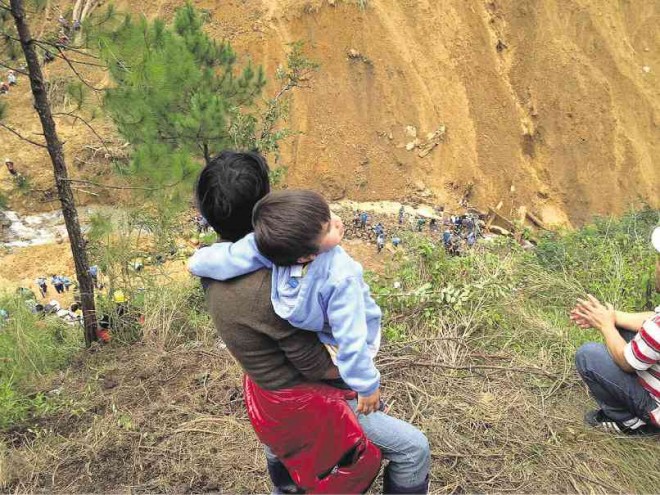
WAITING FOR WORD Adrian, the 4-year-old son of Crisanto Ablao, one of 11 miners who have been missing since Saturday when a landslide crushed their mine camp in Mankayan, Benguet province, during Typhoon “Ineng’s” onslaught, joins other families awaiting for news about their loved ones. RICHARD BALONGLONG/ INQUIRER NORTHERN LUZON
MANKAYAN, Benguet —Adrian, the 4-year-old son of missing small-scale miner Crisanto Ablao, kept shouting for his father on Tuesday as the rest of his family stood quietly on a mountainside in this mining town, more than 100 kilometers north of Baguio City.
“Daddy, please show yourself!” the boy yelled.
About 18 meters below them, policemen, soldiers and volunteers dug through a 270-meter stretch of mud that swept shanties of small-scale miners down to a creek on Saturday.
The body of Efren Balicdan was recovered on Monday, bringing the death toll from the mudslide there to five.
But there was no sign of Ablao and 10 other miners and their family members who may have been buried by the slide that hit their camp as continuous rain triggered by Typhoon “Ineng” pounded the mountainside in Sitio Elizabeth in Barangay Taneg here.
Their absence has given their relatives some measure of hope.
The Office of Civil Defense (OCD) in the Cordillera said teams were searching for Ablao, Ronaldo Angel, Paulita Caluten Angel, Ronald Paul Caluten Angel, Nardo Mocnangan, Marvin Collado Baturi, Harold Collado Baturi, Rocky Mangrubang, John Aluyan Jr., Jose Aluyan and Mark Balicdan.
However, strong rain made the search harder and more dangerous.
Intermittent rain also continued in Baguio and other parts of the Cordillera. Offices, business establishments and schools went back to normal operations, especially after the power supply was restored.
According to the Department of Public Works and Highways, 16 national roads remained closed due to landslides, including Kennon Road, a major route to and from Baguio. A massive landslide blocked a section of Kennon Road in Camp 7 village.
The OCD said the typhoon damaged crops worth P83.2 million and infrastructure worth P47 million.
In Pangasinan, water levels in the province’s rivers receded gradually, but flooding threatened riverside communities, an official of the Agno River Basin Flood Forecasting and Warning Center said on Tuesday.
Lorenzo Diaz, head of the center, said water levels in the Agno, Sinocalan, Ingalera and Tagamusing rivers stayed above alarm levels and could still cause flooding in villages that these rivers traverse.
The Sinocalan, Ingalera and Tagamusing river system runs through the towns of Sta. Barbara, Calasiao, Binmaley, Binalonan, Malasiqui, and Urdaneta and Dagupan cities before draining into the Lingayen Gulf.
The Agno, Pangasinan’s longest river with headwaters located in the mountains of Benguet, traverses the towns of San Nicolas, San Manuel, Asingan, Tayug, Sta. Maria, Balungao, Rosales, Villasis, Sto. Tomas, Alcala, Bautista, Bayambang, Urbiztondo, Mangatarem, Aguilar, Bugallon, Labrador and Lingayen, and San Carlos City.
Diaz said the amount of rainfall in the Cordillera had gone down in the last two days, reducing the volume of water flowing into the rivers.
But he said the rivers contained more water than their natural capacities, which he estimated to be 60 percent more than the normal water volume.
The Ambayaoan and Banila rivers, which flow to the Agno River, also receded, but the San Roque Dam continued to spill water into 18 towns and San Carlos.
At 6 a.m. on Tuesday, two of the dam’s spillway gates were still at 1.5 m high each, spilling water at 531 cubic meters per second. A cubic meter is equivalent to 1,000 liters or five drums of water.
Valeriano Barro, flood operations manager of National Power Corp., said the dam would continue to release excess water until such time that the water elevation goes down to the normal high of 280 meters above sea level.
At 6 a.m. on Tuesday, the water level was 283.01, which was still 3.01 m above normal. The dam can accommodate water up to 290 masl.
As of 8 p.m. on Monday, 10 villages in the towns of Sta. Barbara and Calasiao traversed by the Sinocalan River were still flooded, according to the Provincial Disaster Risk Reduction and Management Office.
Flooding was also reported in 11 villages in the towns of Alcala, Bautista and Bayambang, which are traversed by the Agno River.
Bautista Mayor Amadeo Espino said the flooding of farms in seven villages in his town were caused by an overflowing irrigation system. Reports from Richard Balonglong, Vincent Cabreza and Gabriel Cardinoza, Inquirer Northern Luzon